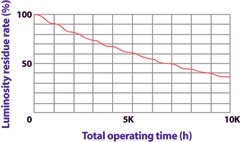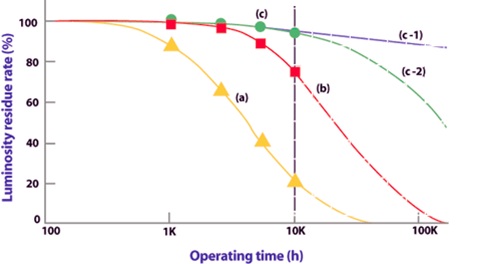
Reliability of LEDs
Longevity Characteristics of LEDs
As mentioned earlier, the luminous intensity of LED lamps characteristically declines slowly with use. Select LED lamps according to the level of reliability require in the equipment in which they will be used. Note the following points when requesting LED lamp reliability data from Toshiba, or when using equipment to test the longevity characteristics.
Temperature Conditions of LEDs
It may be useful to calculate such information as the longevity characteristics (at high temperatures, normal temperatures, and low temperatures) of a discrete LEDs in an environment in which the equipment will be actually used, and to test those calculations by test operation of the equipment.
Humidity Conditions of LEDs
Depending on the material used in an LED, operating the LED under high-humidity, high-temperature conditions can dramatically reduce its lifetime. When an LED may be used under high-humidity, high-temperature conditions, be sure to check its longevity characteristics.
Current Conditions of LEDs
Because lattice defects increase with use, the luminous intensity of LEDs gradually declines. The speed of accumulation of lattice defects depends on the magnitude of the forward current.
Others Factors of LEDs
When using a LED under conditions where factors such as vibration, shock, gas, or ultra-violet affect the leads or resin, Marktech recommends testing the LED separately for each potential affecting factor.
Disconnection Mode of LEDs
As described in the section on the structure of LEDs, placing excessive stress on an LED or subjecting it to extreme temperature changes may result in its disconnection. Factor as differences in the thermal coefficient of expansion and varying levels of mechanical stress can adversely effect chip mounting, bonding wire, leads and resin. The normal test for disconnected LEDs is the temperature cycle test.
LED Lamp Temperature Cycle Test
Toshiba temperature cycle tests are normally performed on the LED lamp structure at the upper-limit storage temperature and the lower-limit storage temperature.
Equipment Temperature Cycle Test
LED lamps are incorporated into equipment by soldering. The reliability of an LED which has been soldered into a piece of equipment cannot be deduced from the results of temperature cycle tests on loose LEDs that have not been incorporated into a piece of equipment. Hence, Marktech recommends conducting temperature cycle testing and reliability testing on LEDs which have already been soldered into place in a piece of equipment.
Longevity Simulation
LED lamp longevity simulation techniques currently in use have failed to establish a correlation between longevity and the tendency for luminosity to deteriorate in actual applications. A further problem is the difference between the ambient temperatures for loose LED lamps not used in equipment and the ambient temperature for those combined into equipment. The following examples show how simulation can be to obtain such information. For simplicity the characteristics of a hypothetical LED lamp are used. Example (a): Simulate the longevity of an LED lamp incorporated in control equipment installed in a room in which high-temperature equipment is operating.
Environment
High-temperature equipment operates for 1,080 hours a year (three hours a day x 360 days) with a forward current of 20 mA
LED lamp ambient temperature is 60°C, 60 days per year, humidity=”90%”
LED lamp ambient temperature is 40°C, 90 days per year, humidity=”90%”
LED lamp ambient temperature is 25°C, 210 days per year, humidity=”90%”
LED lamp longevity characteristics: Figure 17 shows the longevity characteristics of LED lamps.
REL Luminosity vs Time
Figure 17 – Simulation longevity characteristics
Simulation Example
Calculating the LED lamp operating time per year by ambient temperature.
Condition 1 operating time: 3 hours x 60 days = 180 hours
Condition 2 operating time: 3 hours x 90 days = 270 hours
Condition 3 operating time: 3 hours x 210 days = 630 hours
The deterioration characteristics of Figure 17 were applied to each ambient temperature using the above rates of operation.
Figure 18 shows the results. In the example, the longevity characteristics are simulated by the approximate equation exp(-8 t), with 8 changing each time. Where the curve time constants for the characteristics in Figure 17 are 81, 82, 83 and luminosity reduction rate = exp (-8nt), the calculation is made by assigning 8 to each operating time.
Note: It is not possible to represent all the different longevity characteristics by a single approximate equation. It would be risky to extrapolate the characteristics over ten or 20 years based on the above examples and except the results to be accurate, even if the daily operating time were short. REL Luminosity Residue vs Time 1

Figure 18 – Simulation example
Recent improvements have reduced the tendency for LED lamp luminosity to decline with use. The results of long-term studies of longevity characteristics now show that the luminosity need not always attenuate. The decline in luminosity that occurs during use has been evaluated using a Wiebel distribution function. Sometimes, even after thousands of hours of longevity testing, the M-value does not change thousands of hours (see Figure 19). REL Luminosity Residue vs Time 2
Figure 19 – Predictions from longevity test results (a), (b), (c)
With the tendency for luminosity to deteriorate already confirmed by the results of long-term longevity tests in Figure 19 (a) and (b), longevity can now be predicted relatively easily. However, in Figure 19 (c), no deterioration is seen, even after 10,000 hours of use. It is not possible to decide whether deterioration proeeds in the (c-1) direction or the (c-2) direction. In some cases, the deterioration in the M-value is large after a certain point, as in (c-2). The absence of luminosity reduction during longevity tests does not mean that the LED lamp will not deteriorate at some point in its life. When determining the location in which a piece of equipment incorporating an LED is to be used, if necessary perform longevity testing under accelerated conditions, so as to predict the longevity characteristics based on the actual conditions of use.View Products
Find something you were looking for? Get a free no-obligation quote today.
